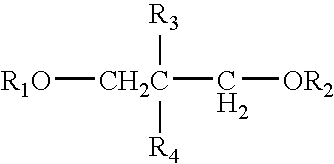Polyolefin Composite Material And Method For Producing The Same
a polymer alloy and composite material technology, applied in the field of polymer alloy preparation, can solve the problems of difficult to widely use those techniques, difficult to implement the mechanical blending method, and difficult to thoroughly blend the polymer, and achieve the effect of adjusting the performance of the polymer alloy purposively
- Summary
- Abstract
- Description
- Claims
- Application Information
AI Technical Summary
Benefits of technology
Problems solved by technology
Method used
Image
Examples
example 1
[0042]4 g spherical alcohol-MgCl2 carrier (molar ratio of ethanol: MgCl2=1:1) was added into a preparation flask, and then the flask was vacuumized and charged with argon gas. Then 200 ml TiCl4 was added thereto at −20° C., followed by agitating, and heating up to 80° C. Next, 2 ml fluorene diether was added thereto, and agitated for 1.5 h. After vacuum filteration, 200 ml TiCl4 was added and the resulting mixture was dried, to obtain the non-homogeneous Zieglar-Natta catalytic component.
[0043]0.028 mmol solid Me2Si[2-Me-4-Naph-Ind]2ZrCl2 compound was put in a two-necked flask charged with argon gas, and 22.4 ml 2.5M toluene solution of methylaluminoxane (MAO) was added. Then, the resulting mixture was agitated, heated up to 90° C., and kept at 90° C. for 0.5 h. The above agitated metallocene compound was mixed with 2.8 g non-homogeneous Zieglar-Natta catalytic component in nitrogen gas at 0° C. The resulting mixture was agitated for 24 h, filtered, washed with methylbenzene and hex...
example 2
[0044]2 g spherical alcohol-MgCl2 carrier (molar ratio of ethanol:MgCl2=4:1) was added into the preparation flask, and then the flask was vacuumized and charged with argon gas. Then, 100 ml TiCl4 was added thereto at 0° C., followed by agitating, and heating up to 80° C. Next, 20 ml fluorene diether was added thereto, and agitated for 1.5 h. After filteration, 100 ml TiCl4 was added, and the resulting mixture was heated up to 130° C., kept for 2 h, filtered and dried in vacuum, to obtain the non-homogeneous Zieglar-Natta catalytic component.
[0045]0.28 mmol solid Et(ind)2ZrCl2 compound was added in a two-necked flask charged with argon gas, and 112 ml 0.5M toluene solution of trimethyl aluminum (TMA) was added. Then, the resulting mixture was agitate for 24 h at 0° C.
[0046]The above metallocene compound solution was mixed with 0.5 g non-homogeneous Zieglar-Natta catalytic component in argon gas. The resulting mixture was agitated at 40° C. for 6 h, filtered, washed with methylbenzene...
example 3
[0047]4 g spherical alcohol-MgCl2 carrier (molar ratio of ethanol:MgCl2=2.6:1) was added into the preparation flask, and then the flask was vacuumized and charged with argon gas. Then, 160 ml TiCl4 and 3.0 ml dibutyl phthalate were added at −10° C. The resulting mixture was agitated, heated up to 110° C., kept for 1.5 h, and washed with hexane for 4 times, to obtain the product in which the Ti content is 3.38%.
[0048]4 mmol solid Cp2TiCl2 compound was put in a two-necked flask charged with argon gas, and 143 ml 1.4M heptane solution of triisobutylaluminum (TIBA) was added thereto. The resulting mixture was agitated, heated up to 40° C., and kept for 5 h.
[0049]The above metallocene compound solution was mixed with 2 g non-homogeneous Zieglar-Natta catalytic component in nitrogen gas. The resulting mixture was kept at 80° C., agitated for 1 h, filtered in vacuum, washed with hexane for 6 times (30 ml for one time), and dried in vacuum, to obtain the composite catalyst C. The compositio...
PUM
| Property | Measurement | Unit |
|---|---|---|
| Temperature | aaaaa | aaaaa |
| Temperature | aaaaa | aaaaa |
| Temperature | aaaaa | aaaaa |
Abstract
Description
Claims
Application Information
 Login to View More
Login to View More - R&D
- Intellectual Property
- Life Sciences
- Materials
- Tech Scout
- Unparalleled Data Quality
- Higher Quality Content
- 60% Fewer Hallucinations
Browse by: Latest US Patents, China's latest patents, Technical Efficacy Thesaurus, Application Domain, Technology Topic, Popular Technical Reports.
© 2025 PatSnap. All rights reserved.Legal|Privacy policy|Modern Slavery Act Transparency Statement|Sitemap|About US| Contact US: help@patsnap.com



